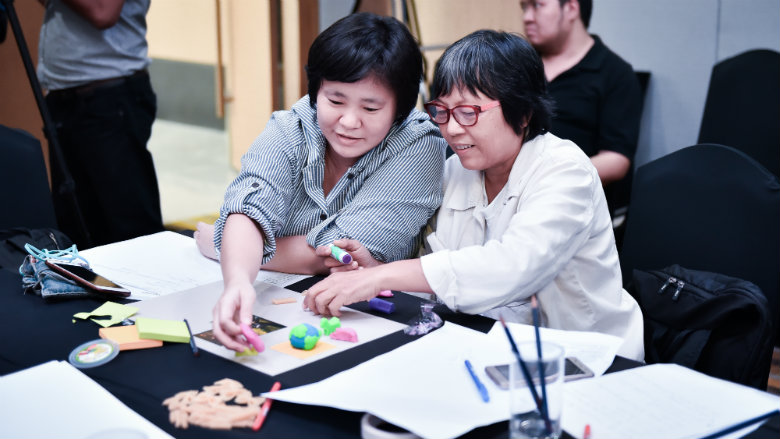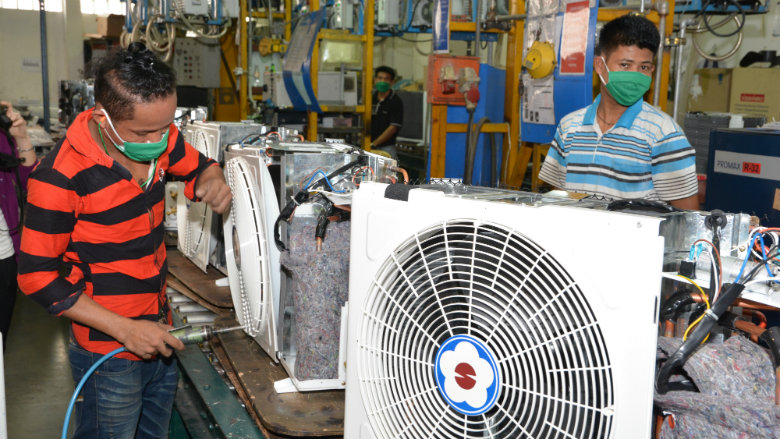Challenge
Cooling and refrigeration are essential to increasing labor productivity, improving educational outcomes, safeguarding food and minimizing its waste, improving healthcare, and supporting countries’ digital ambitions. But all this is also contributing to climate change as various compounds used as refrigerants are not only ozone-depleting substances but also potent greenhouse gases.
Thailand, the second-largest producer of air conditioners in the world, manufactures approximately 16 million air conditioners annually, 90 percent of which are for export. Thailand is also one of the 10 largest importers and consumers of hydrochlorofluorocarbon chemicals (HCFCs), importing more than 18,000 metric tons in 2012. One of the central goals of the government is to introduce environment-friendly production into Thailand's industries and to embrace the concept of green industries.
Since Thailand ratified both the Vienna Convention for the Protection of the Ozone Layer and the Montreal Protocol on Substances that Deplete the Ozone Layer, it is obliged to phase-out chlorofluorocarbons (CFC) and HCFCs.
The HCFC phase-out schedule has posed key challenges to a number of Thai residential air conditioner manufacturers as well as small- and-medium-scale enterprises (SMEs) in the foam sector that produced various types of insulation foam products. Timely implementation of HCFC phase-out through a combination of investment and policy interventions were undertaken to prevent business disruption.
With the World Bank support through this project, Thailand completely phased out CFCs in 2010 and aims to phase out HCFCs completely by 2030.
Approach
For almost 25 years, the World Bank has assisted Thailand as an implementing agency of the Multilateral Fund for Implementation of the Montreal Protocol. Since 1994, more than $70 million has been made available to support the phase-out of harmful CFC and HCFC chemicals in Thailand. The Bank has worked closely with Thai industries for more than two decades to transfer technology and know-how on ozone and climate-friendly technology to the private sector, as well as providing policy and technical advice to relevant government agencies. The key contribution is the Bank’s advice on the appropriate alternative technological pathway as well as the robust project design hinging on a proper policy framework and a series of timely investment intervention to ensure successful implementation of the project in phasing-out of the ozone depleting substances.
An example is the successful transformation of the Thai residential air conditioner market. The Bank’s convening power was instrumental in setting up an open dialogue among Thai air conditioner manufacturers and the sole provider of new technology that uses a more ozone and climate-friendly hydrofluorocarbon (HFCs) refrigerant that has a global warming impact of only one-third of HCFCs. The Bank assisted Thai manufacturers in gaining access to the new technology and know-how free of charge from the technology provider, and unlocked the supply of new air conditioner components that were essential for technology conversion. The early adoption of this new technology has enabled Thai manufacturers to expand their export market in developed countries.
For the foam sector, grants under the Multilateral Fund were provided directly to eligible enterprises with sufficient technical and financial capacity to carry out the conversion to climate-friendlier technologies on their own. Small foam enterprises with limited technical and financial capacity received support from companies that supplied them raw materials.
Finally, the conversion in the two sectors was bolstered by a ban of HCFCs in the air conditioner and foam sectors (except spray foam). This combination of investment incentives, policy change, and market drivers led to the project’s success and sustainability.
Results
The total climate benefit since the start of the project from 1994 to 2014:
- More than 38.21 million carbon dioxide (CO2) emission reduction per year. This is equivalent to removing about 8.1 million passenger cars off the road, or shutting down emission from almost 10 coal fire power plants
- Given that the total grant funds to support this program thus far is about US$80 million, the cost of CO2 emission reduction is US $2.09 per CO2, which is very cost effective compared to other climate mitigation measures.
- More than 80 small- and medium-sized foam manufacturers have changed their production technology to non-ozone depleting and low climate impact alternatives, resulting in a total permanent phase-out of more than 1,200 metric tons of HCFC, which is equivalent to a reduction in greenhouse gas emissions by 870,000 tons of CO2 per year.
- Eleven residential air conditioner manufacturers have changed their production to non-ozone depleting and low climate impact alternatives. At the completion of the project, total consumption of HCFC was reduced by more than 5,000 metric tons.
- Thailand has secured its standing in the global market and maintained its competitiveness as the second largest residential air conditioner manufacturer in the world – manufacturing more than 16 million units a year.
In terms of Thailand’s achievements, it was the first country that:
- Proposed to the Multilateral Fund to use a performance-based approach project for permanent reduction of the use of ozone-depleting substances like CFCs and HCFCs. The fund enabled the government to come up with a long-term policy to restrict import and use of these substances.
- Banned the manufacturing and import of CFC refrigerators in 1997. It was also the first country to transform the air-conditioner market from HCFCs to new technology that was more ozone and climate-friendly in 2017.
- Implemented the building air-conditioner replacement project to improve energy efficiency and phase out CFCs at the same time. This dual benefit (ozone and climate) approach is now included in the design of the Kigali Amendment to the Montreal Protocol.
World Bank Group Contribution
The World Bank’s engagement in ozone protection and cooling industries development
in Thailand was through its implementation of the Multilateral Fund under the Montreal Protocol, which provided in total about US$80 million in grant funding. The Bank’s convening power and its role as a neutral broker has enabled various stakeholders to share their concerns and interests to help reach a mutually agreed path forward for the phaseout.
Partners
The project built a strong and effective advisory and operational partnership with the Department of Industrial Works, serving as the national ozone unit and primary project management unit, working in close collaboration with the Customs Department to ensure effective monitoring of the import quota of the ozone depleting substances. The Bank team also closely cooperated with the Federation of Thai Industries, particularly for the air conditioner and foam sectors, to ensure the effective implementation of the project. The Government Savings Bank also served as the other project management unit to act as a financial agent to monitor and supervise the disbursement of the sub-grants. The project also conducted training for the Department of Skill Development and Office of Vocational Education Commission to strengthen capacity of their trainers and instructors to comply with good practices for installation and servicing of the more climate-friendly HFC air conditioners.
Moving Forward
Thailand has made great strides to phase out ozone-depleting substances as a member of the Montreal Protocol. Thailand’s next step will be ratifying the Kigali Amendment to the Montreal Protocol to phase down consumption of hydrofluorocarbons (HFCs). Given their zero impact on the depletion of the ozone layer, HFCs are currently used as replacements of hydrochlorofluorocarbons (HCFCs) and chlorofluorocarbons (CFCs), however they are still powerful greenhouse gases with global warming potential.
The World Bank will support the Kigali Amendment by helping countries, including Thailand, phase down HFCs and improve energy efficiency in air conditioning and refrigeration, resulting in reduced emissions, decreased peak demand for electricity, and lower consumer electricity costs.
The Bank also aims to establish and strengthen networks among key stakeholders to ensure smooth implementation, including raising consumers’ awareness on how to properly maintain their appliances by having only qualified technicians provide regular services to their equipment. This will not only extend the service life of their appliances but also maximize their energy efficiency performance. In November 2018, the Bank also supported Thailand’s Department of Industrial Works to conduct the first Policy Hackathon with more than 300 participants from various stakeholders, ranging from students, private entrepreneurs, to farm owners – to develop a bottoms-up policy on ozone protection. This first Policy Hackathon was well-recognized by the other Montreal Protocol parties with a potential to be replicated elsewhere.

